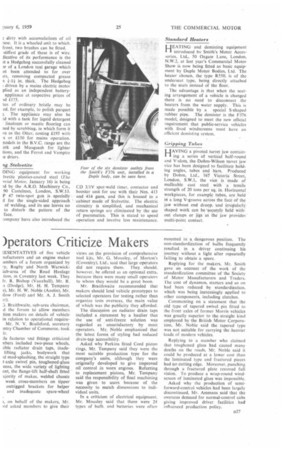)perators Criticize Makers
Page 69

If you've noticed an error in this article please click here to report it so we can fix it.
LESENTATIVES of five vehicle nufacturers and an engine maker embers of a forum organized by ry, Rugby and North Warwick.; iub-area of the Road Haulage tion, in Coventry last week. They Ir. R. Bishop (Vauxhall), Mr. R. is (Dodge), Mr. H. H. Tempany s), Mr. H. W. Noble (Austin), Mr. tlow (Ford) and Mr. A. J. Smith 1 Braithwaite, sub-area chairman, d the forum to allow members tion makers on details of vehicle in relation to operational requireMr. N. V. Brailsford, secretary :ntry Chamber of Commerce, took de features and fittings criticized nbers included two-piece wheels, iible radiator drain taps, madelifting jacks, bodywork that tcl mud-splashing, the straight type t-axle swivel pin, toughened-glass eens, the wide variety of lighting cnt, the flange-lift half-shaft fitted ajority of makes, welded chassis weak cross-members on tipper outrigged brackets for helper and inadequate spare-wheel 1, on behalf of the makers, Mr. 'rd asked members to give their views on the provision of comprehensive tool kits, Mr. G. Mousley, of Morton's (Coventry), Ltd.; Said that large operators did not require them. They should, however, be offered as an optional extra, because there were many small operators to whom they would be a great boon.
Mr. Braithwaite recommended that makers should lend vehicle prototypes to selected operators for testing rather than organize tests overseas, the main value of which was the publicity they afforded.
The discussion on radiator drain taps included a statement by a haulier that the use of anti-freeze solution was regarded as unsatisfactory by most operators. Mr, Noble emphasized that the latest forms of styling had reduced drain-tap accessibility.
Asked why Perkins fitted Cord piston rings, Mr. Tetnpany said they were the most suitable production type for the company's units, although they were originally developed to give improved oil control in worn engines. Referring to replacement pistons, Mr. Tempany said the responsibility of final machining was given to users because of the necessity to match dimensions to individual units.
In a criticism of electrical equipment. Mr. Mousley said that there were 24 types of bulb. and batteries were often mounted in a dangerous position. The non-standardization of bulbs frequently resulted, in a driver continuing his journey without a light after repeatedly failing to obtain a spare.
Replying for the makers, Mr. Smith gave an account of the work of the standardization committee of the Society of Motor Manufacturers and Traders. The cost of dynamos, starters and so on had been reduced by standardization, which was being increasingly applied to other components, including clutches.
Commenting on a statement that the old type of tapered swivel pin fitted to the front axles of former Morris vehicles was greatly superior to the straight kind employed by the British Motor Corporation, Mr. Noble said the tapered type was not suitable for carrying the heavier loads of modern vehicles.
Replying to a member who claimed that toughened glass had caused many deaths on the roads, Mr. Noble said it could be produced at a lower cost than the laminated type and fractured pieces had no cutting edge. Moreover, punching through a fractured plate restored full vision. To produce a wrap-round windscreen of laminated glass was impossible.
Asked why the production of semiforward-control vehicles had been largely discontinued, Mr. Ammans said that the overseas demand for normal-control cabs giving improved driver facilities had influenced production policy.




























































































































